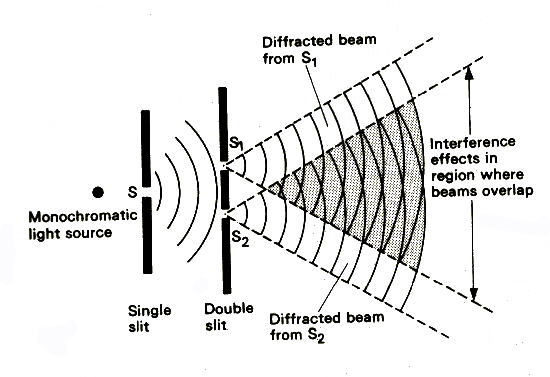
9.2.2 The
significance of Young’s experiment
Thomas Young was the
first person to demonstrate the wave like nature of light (1803). He showed that
when light was passed through two narrow slits that an interference pattern was
produced. Since interference is a wave behaviour it disproved the corpuscular
theory of light.
Young’s fellow
scientists were reluctant to accept his findings because they were still
considering light in terms of a longitudinal wave propagated through the
‘ether’ which had evaded all attempts at detection. Also the phenomenon of
double refraction could not be explained by a longitudinal wave.
Double refraction is
exhibited by calcite crystals called Iceland Spar. Two refracted rays are
produced by just one incident ray. One of the refracted rays was found to obey
all the laws of refraction ; the other ray did not and was termed the
extraordinary ray. The explanation of the behaviour of the extraordinary ray
relies on the polarisation direction of the incident ray relative to the
orientation of the molecules in the crystal. Since Young and his contemporaries
were thinking in terms of longitudinal waves, which cannot be polarised, they
could not explain their observations. It took 15 years for Young to realise that
a transverse wave could explain the effect and in 1819 Augustin Fresnel devised
a mathematical explanation of double refraction based on transverse waves.
Interference occurs
when light from two coherent sources cross. Coherent sources produce waves which
have the same frequency, similar amplitudes and a phase difference that does not
alter with time. The wavelength of light must be very small otherwise
diffraction effects would be much more noticeable than they are. Therefore
following experiments with a ripple tank it is clear that the two sources must
be very close together and the screen or viewing arrangement must be as far away
as possible.

The single slit
transmits light from the lamp which then falls on the double slit. Each of the
double slits transmits a diffracted beam toward the screen so that there is an
area where the diffracted beams overlap. Interference fringes are seen in the
area where the beams overlap.
Dark fringes are seen
in the positions where light waves from one slit arrive 180° out of phase with
waves from the other slit. Bright fringes are seen in positions where waves from
one slit arrive in phase with waves from the other slit.
Different colours of
light give equally spaced bright and dark fringes parallel to the slits. The
spacing of the fringes does depend on the colour (wavelength) of the light. Red
light gives a greater fringe spacing than blue light.